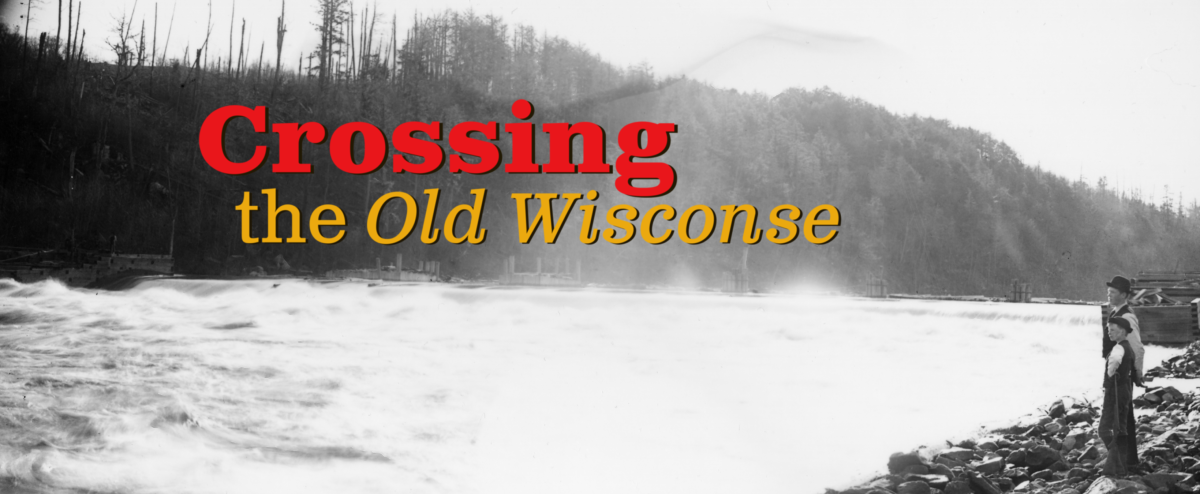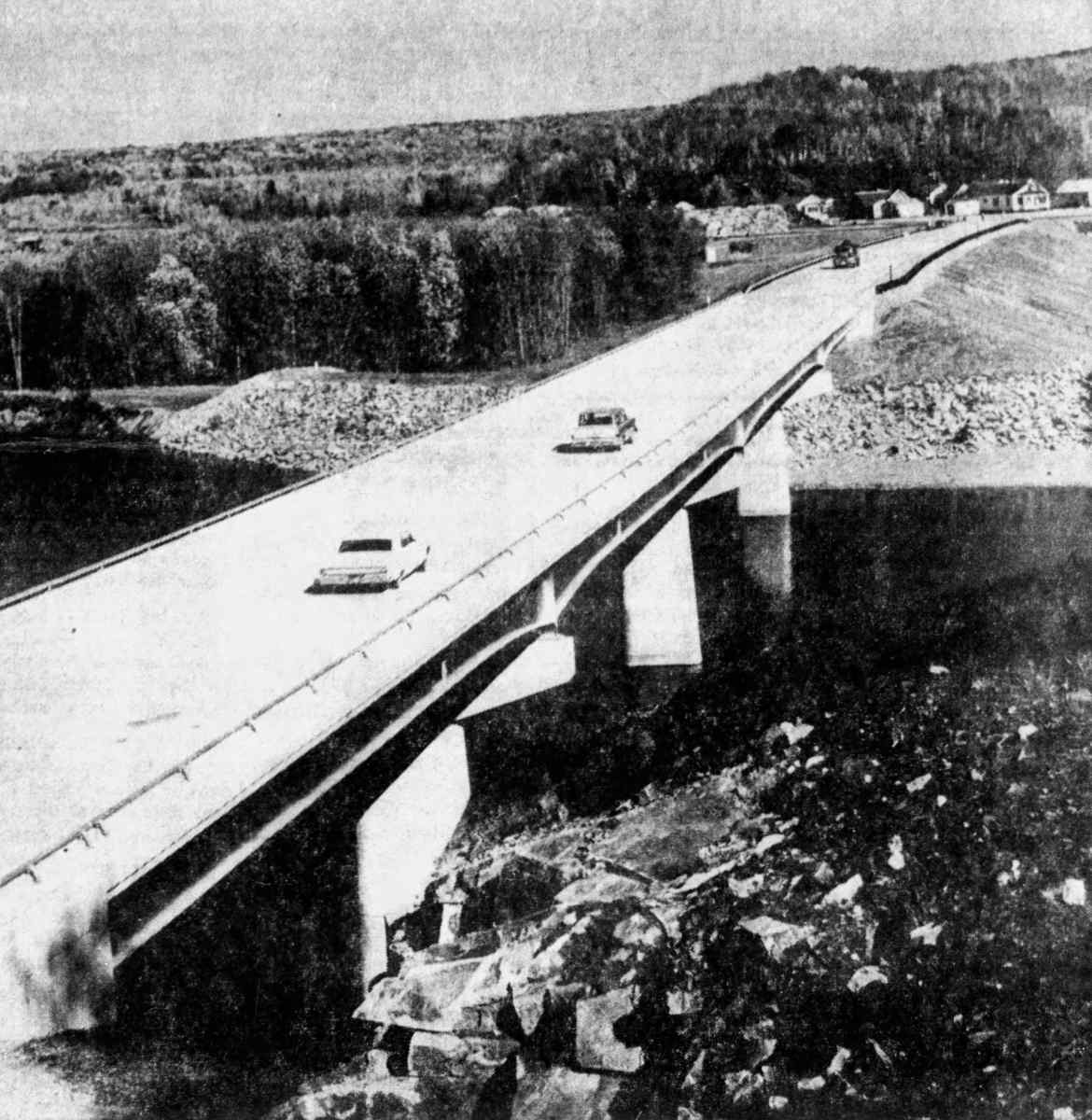A Bridge for Brokaw

In January of 1962, a heavily laden semi-truck making the descent down Brokaw Hill lost control and jack-knifed, blocking the only road into the Village of Brokaw. The resulting mess took hours to clean up and left the village and its paper mill isolated for most of the day.1 With no way in or out of the village, had a fire started or a medical emergency occurred there would have been no help from the outside world; It was through sheer luck that catastrophe was averted. The event got people thinking, this time the roadblock was just a single truck, what if next time it was a pileup? What would happen if a blizzard buried the road and it took days to clean up?
An an aerial view of Brokaw. The often treacherous road down Brokaw Hill can be seen in the background.
Credit: MCHS Photo Collection
Senator Smith Steps In
It should be noted that Brokaw was an isolated community even when the road was open. County Road WW, which carried the only road into the village, came in from the east, making a steep and winding descent into town down Brokaw Hill. The road was prone to blockage by adverse weather conditions and for heavy vehicles, such as the never-ending parade of tractor-trailers carrying supplies to the local mill, it was treacherous even at the best of times. With no road from the west, just getting to the neighboring community of Maine on the opposite bank of the Wisconsin River involved a 20 minute detour through either Wausau or Merrill. What the village needed was not only another road but a river crossing.
Brokaw found a champion in Wisconsin State Senator Charles F. Smith of Wausau. Under Senator Smith’s guidance, a petition was circulated, eventually gathering over 1,000 signatures.2 In 1963 Smith presented the petition to the chairman of the State Highway Commission and was informed that the commission had already begun a preliminary survey and was proceeding with the project.3 What followed was a year of surveys and studies by both state and county highway authorities. Traffic counts were conducted in the adjacent communities of Wausau and Merrill to determine the impact of traffic from Brokaw using their bridges. Surveys were distributed among Brokaw citizens as well as employees of Wausau Paper Co. and the pulpwood haulers that serviced its mill. The consensus among all was that a bridge was needed somewhere between Wausau and Merrill, and that Brokaw was the optimal location.4 In January 1964, Senator Smith was told that the project would likely qualify for both state and federal aid, but because of the unique construction problems posed by the area’s rugged terrain, the project would still cost the county several hundred thousand dollars. Smith, who was on the state Highway Committee, promised to do whatever he could to aid the project and secure additional funding.5
Another Wreck at Brokaw
Even with Senator Smith’s steadfast support, things took time. Several months passed before more was heard of the project’s status. In the meantime, another truck crashed on Brokaw Hill. As the loaded pulp truck was descending the hill into town its brakes failed, and the resulting rollover flooded the Brokaw School grounds with wood pulp.6 The accident understandably frightened and upset residents. It was one thing to have a truck block the only road into town but another thing entirely to have one narrowly miss plowing through the elementary school. In the wake of this near disaster, Senator Smith returned from Madison with good news, the project had been greenlit by the state and had passed it along to the Marathon County Board where it was currently in committee.7 By the following year the project, which had met with near-unanimous approval, had cleared the County Board, and the discussion of who would pay for what could begin. The project was estimated to cost $735,000 with the county agreeing to pay $245,000;8 anything else not covered by state and federal funds would have to be taken care of on a municipal level. Both the Village of Brokaw and the Town of Maine were asked to contribute to the project at a rate of one-half of one percent of their respective equalized valuations, approximately $50,600 from the village and $50,125 from the town.9 There was some question as to whether or not Maine should have to pay for the bridge at all. In the years before the project, Brokaw had annexed a portion of land on the West side of the river and officials from Maine were quick to point out that it was possible the new bridge would be entirely within Brokaw Village limits.10 In response to this, Brokaw offered to assume half of the cost of the project allocated to the Town of Maine meaning that the township would only have to pay about $25,000.11 Just four days later the Town of Maine accepted the offer at a special town hall meeting. Over 40 Maine Residents, who were likely just as eager as their Brokaw counterparts, showed up to voice their support for the new bridge.12
Construction Begins
With funding taken care of, actual construction was scheduled to start in October 1966. The primary construction contract was let to Pagel Construction of Almond, Wisconsin; their bid came in slightly over projected costs at $811,150, but the difference was projected to be covered through a mix of State and county funding.13 The Bridge would be four spans and feature a 580-foot steel superstructure,14 with a total length of 670 feet including approaches.15 With pilings already in transit to the site and the bridge’s steel beams scheduled to arrive in April Pagel intended to work through the winter to make the deadline, stating, “We’ll go until stopped by the weather.”16 The deadline of September 6th, 1967 was a tight one, giving contractors only 300 days from start to finish,17 but by February, workmen had the three massive concrete supports in place and ready to receive the steel substructure.18 By July of that year, J. L. Sullivan and Sons of Wisconsin Rapids were on site preparing to lay the concrete bridge deck.19 Decking ended up taking slightly longer than anticipated and the bridge was ready for dedication on October 31st, 1967 after 355 days of work.20
A Fanfare Dedication
The dedication was a massive event for such a small village. The dignitaries present for the event included Brokaw Village President Arnold Goetsch; Wausau Mayor John Kannenberg; President of the Wausau Area Chamber of Commerce Clyde Schlueter; Rev. W.H. Ortwein; State Highway Commision Chairman William Redmond; Wasau Paper President D.B. Smith; and County Board Chairman Leroy Jonas. Heading up the already impressive list of dignitaries was none other than Governor Warren P. Knowles who personally cut the ribbon officially opening the bridge to traffic.21 "Ours is a closely knit world," said Governor Knowles at the dedication "We can no longer separate the rural from the urban. What is good for one is good for all."22
Governor Warren P. Knowles delivers his address at the opening ceremony
Credit: MCHS Photo Collection
Taking the Bad with the Good
As with all things the bridge had its good and bad. Some lamented the loss of the old ways. In Brokaw’s 2003 Centennial Celebration Book one resident wrote,
For all the good that the bridge
brought to the community came changes
that would erode the Village’s decades-old
traditions that made it a unique company
town. The changes were gradual, but
profound. For instance, villagers were no
longer as dependent on the company store
for food and the store- the epicenter of
Village social life- would close forever in a
few short years. It was now easier for mill
workers to commute to work from other
communities and, conversely, for Brokaw
residents to work in communities other
than Brokaw.
But, today the bridge that changed
everything in Brokaw is literally
the bridge to the Villages [sic] future.23

Traffic flows over the newly opened Bridge.
Credit: Wausau Daily Herald 1967
Whatever the prevailing opinion of the bridge was, it was there to stay, and actually ended up outlasting the village it was meant to serve. Today with Brokaw and its paper mill gone, the bridge no longer sees the endless string of pulpwood trucks that it was built to handle but it continues on, mostly serving the village of Maine and those traveling between Wausau and Merrill a silent reminder of a high water mark in the long and varied history of Brokaw.
< Previous Story Glossary Main Index Next Story >
1. "Brokaw Bridge Petition Goes to State Road Chief." Wausau Daily Herald (Wausau), April 19, 1963.
2. "Brokaw Bridge Petition"
3. "Brokaw Bridge Petition"
4. "Give Tentative Approval to Brokaw Bridge." Wausau Daily Herald (Wausau), January 22, 1964.
5. "Give Tentative Approval"
6. "Another Brokaw Bridge Argument." Wausau Daily Herald (Wausau), May 25, 1964.
7. "Another Brokaw Bridge Argument"
8. "Brokaw Bridge Fund Voted by County Board." Wausau Daily Herald (Wausau), July 14, 1965.
9. "Brokaw Bridge Cost Meeting Is Set Monday." Wausau Daily Herald (Wausau), June 17, 1965.
10. "Brokaw Bridge Cost Meeting"
11. "Brokaw Bridge Cost Meeting"
12. “Maine Agrees to Share Cost of Brokaw Bridge.” Wausau Daily Herald (Wausau), June 22, 1965.
13. “Brokaw Bridge Project to Start.” Wausau Daily Herald. (Wausau), October 6, 1966.
14. “Brokaw Bridge Bidding Set Next Month.” Wausau Daily Herald. (Wausau), August 20, 1966.
15. “Brokaw Bridge Unanimously Backed at State Hearing Here.” Wausau Daily Herald (Wausau), November 5, 1964.
16. “Brokaw Bridge Project to Start”
17. "Brokaw Bridge Project to Start"
18. “Work on Brokaw Bridge Progressing.” Wausau Daily Herald (Wausau), February 24, 1967.
19. “Sullivan Low Bidder.” Wausau Daily Herald (Wausau), July 12, 1967.
20. “Brokaw Bridge Open Knowles to Dedicate Oct. 31.” Wausau Daily Herald (Wausau), October 16, 1967.
21. “Brokaw Bridge Is Dedicated.” Wausau Daily Herald (Wausau), October 31, 1967.
22. "Brokaw Bridge Is Dedicated"
23. 2003. Rising By the River.
